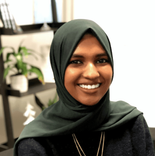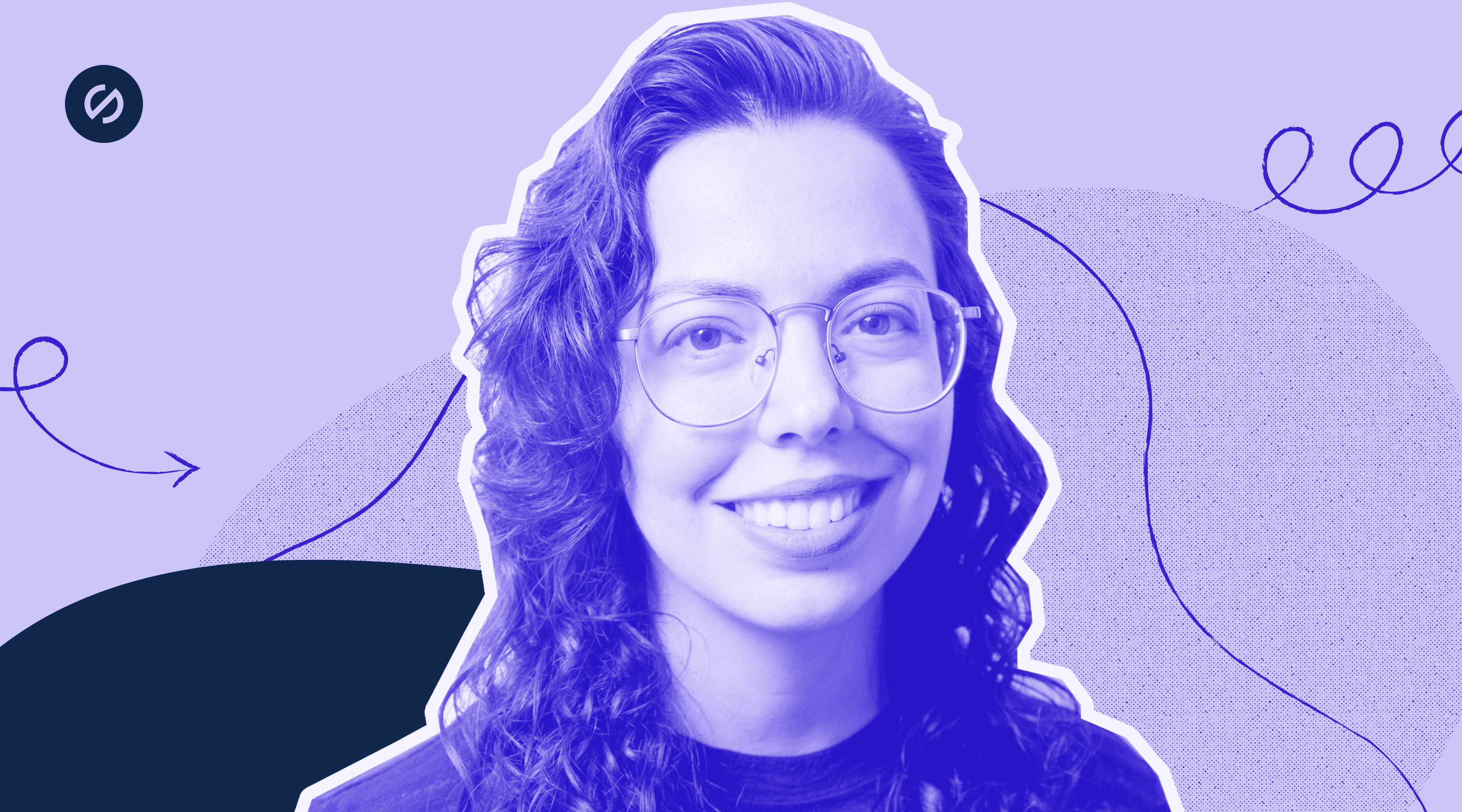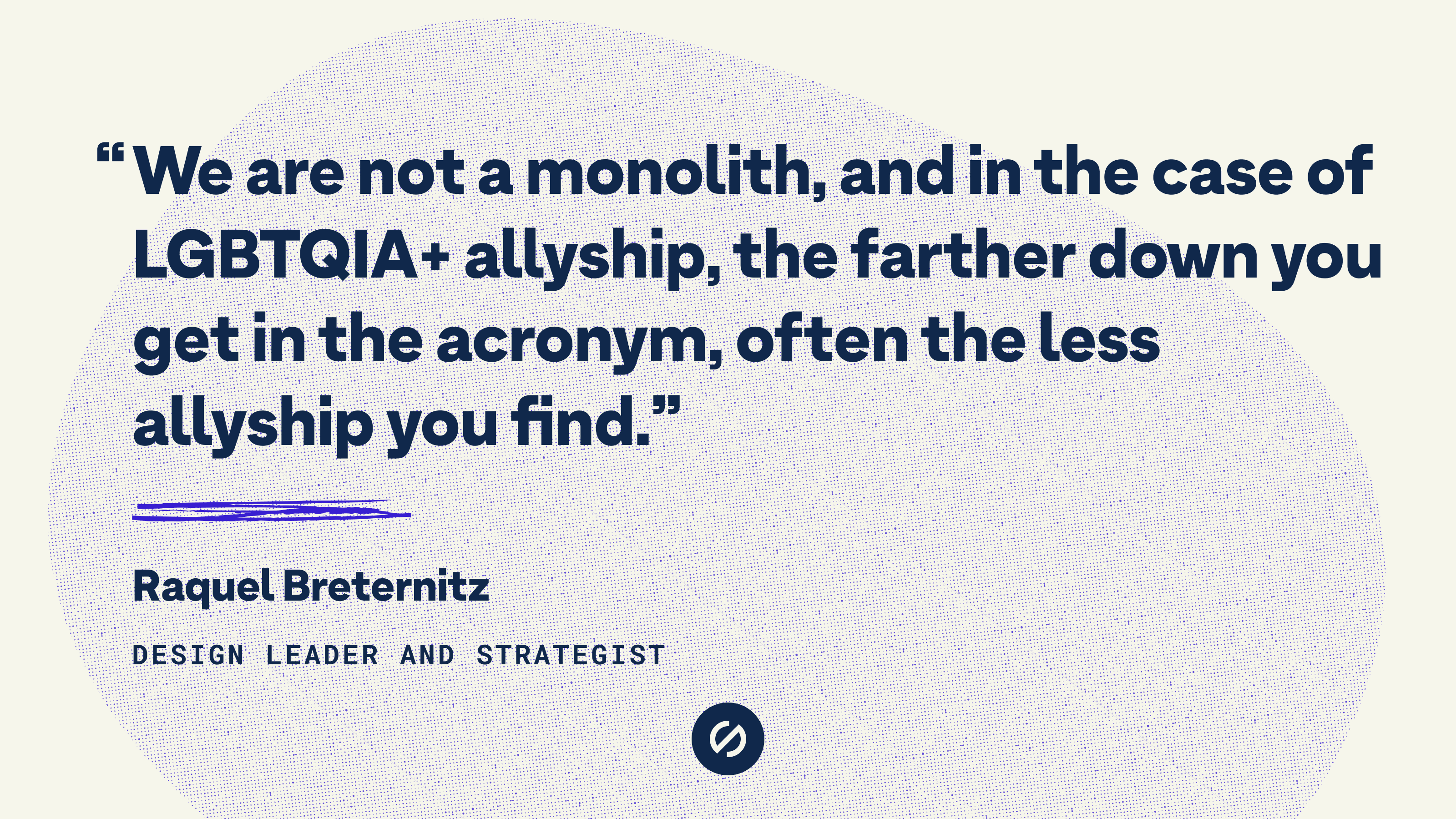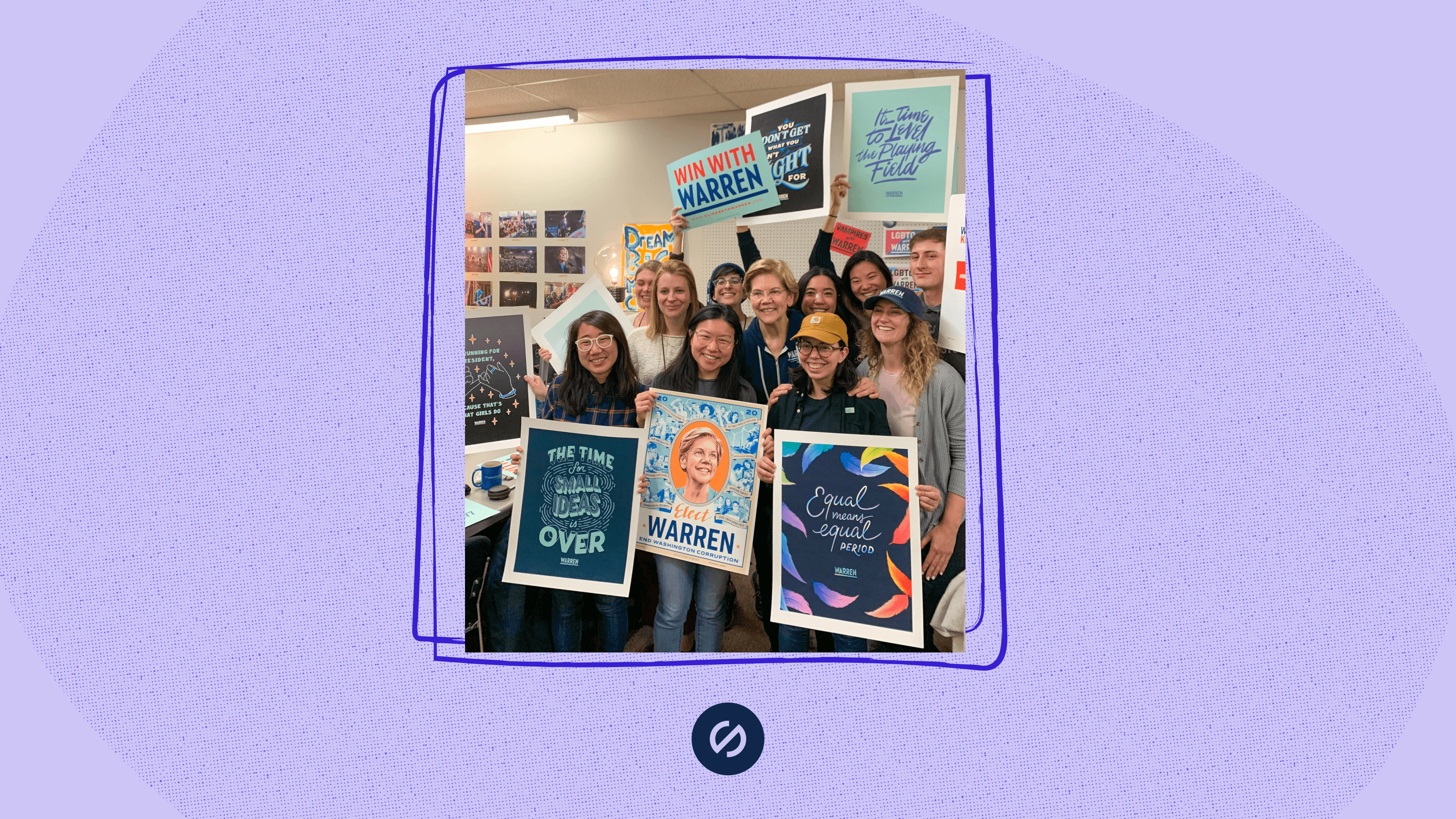Spotlighting Access with Raquel Breternitz
In our latest community Q&A feature Design Leader and Strategist, Raquel Breternitz, shares her insights and experiences around building accessible products, designing an inclusive political campaign and more.

Sagal Muse
Jun 29, 2021

Raquel Breternitz is a Design Leader and Strategist based in Austin, Texas, who loves to write and illustrate on the side. Raquel’s work and speaking topics are connected by a passion for accessibility and inclusion, research-driven design thinking, and a hunger for tackling complex, and challenging problems. In today’s community feature, we’re excited to share some of Raquel's brilliant insights and experiences around building accessible products, designing an inclusive political campaign and what true allyship looks like for the LGBTQIA+ community.
What inspired you to get into design and more specifically accessible design?
This is a huge question! I'll answer the second one — when I was a baby visual designer, my first year at IBM Design in Austin, I had an experience one day when I was testing out a visual prototype with users for the first time.
One woman was really struggling to get through the flow, to all our consternation. It seemed to us it should have been obvious (a bad look for us, in retrospect). About 10 minutes in she began apologizing profusely, and said "I'm so sorry, young lady, I can't see very well so I'm not finding the right place to go for you." She sounded so sad to be disappointing me.
In that moment, everything in me sank. Here I was, touting the virtues of "user-centered design," and a user was apologizing to me for my lack of consideration of her needs. It was a watershed moment for me, and I remembered that we'd had a few lectures from the accessibility group at IBM during our onboarding—a 3-month design thinking "boot camp" of sorts.
I reached back out to the accessibility group that presented to us to learn more, and I started doing a ton of research on accessibility (which expanded to include internationalization, inclusive design, and eventually, disability justice). I put together a small talk based on what I learned about accessibility and why it mattered, and started connecting with a great network of other designers who were inspired and excited by it.
Eventually, through our efforts and others', accessibility was expanded to be more than a few lectures in the boot camp program, and was integrated into all levels of IBM's design language systems and field guides. The design and accessibility groups started collaborating a lot more often. They improved the content of what we taught incoming designers to include weeklong accessibility-focused projects, and we helped significantly improve the design of their site in turn.
I learned more than I ever expected from that first experience, and expanded my understanding of what accessibility is far beyond just color contrast and visual design. That drive for inclusion and better design through accessibility has been a part of my practice since.

Tell us about a time where you experienced an inaccessible or exclusive product. How can product teams make sure that they’re building accessible products for all?
I'm quite privileged in that I'm mostly able-bodied, and I grew up on the internet, so I've found that I've been able to use and figure out most web things—whether or not they were accessible. That being said, two of my personal pet peeves that I encounter often in the world are overly light text and the lack of captions. The former, because I love reading and read a lot online, and when the font is too thin or too light, it really strains my eyes and I'll often give up halfway through an article. I've actually turned on "reader mode" on all my browsers to get around this. When I can, I also like to read outside, and the glare on a screen will murder your font contrast.
The latter is because I'm not an auditory learner, and reading along with speech helps me a lot, especially with accents. One of my favorite shows in recent memory is Derry Girls, and let me tell you, I would have no idea what's going on without captions. I joke that I don't watch videos, but it's really because I hate turning on the sound, whether on my phone or my laptop. For example, I can get the gist of a funny TikTok with captions while in the line at the coffee shop without annoying the hell out of everyone around me. Without them, sorry, but I'm leaving you on read. Or transcripts! I rarely have the patience to listen to a TED talk but I'll skim the transcript all day.
As a former civic tech designer and generally a big nerd, I'm also very opinionated about forms, and it kills me how many easy-win usability bugs could be fixed by designing with accessibility in mind at first.
The best form is one I don't have to fill out! Especially for consumers. I'm thinking about Guest Checkout, and the old Goodreads "we'll log you in automatically" feature. But when you do have to fill out information, I recall being very impressed with the form to submit information to the government for a clearance (especially because I also had to do it on their old system, so I got a clearance before and after). It got the USDS treatment and was as painless as possible. It broke up things into short, discrete sections that were very scannable and made it easy for me to tab through it all quickly, while auto-filling things when appropriate.
I'll leave it at that before I take over this feature with a rant about form factors...leave it to Adam Silver.
From your perspective, what does true allyship look like for the LGBTQIA+ community?
This is a nearly impossible question, because like any minoritized community, it varies widely by the person. We are not a monolith, and in the case of LGBTQIA+ allyship, the farther down you get in the acronym, often the less allyship you find. That points to what I believe are a few good approaches for allyship, which is actually a loop:
- learn our history and our stories
- step aside and listen
- actively make space, even if it means turning down opportunities yourself, and
- repeat.
And this must include trans people, and trans people of color, and disabled trans people, and disabled trans people of color — it's a horrible function of our brains of having to layer on identities when we hear a word. For example, what do you first see in your mind when I say "man?" What about "trans man?" What about "Black trans man?" What about "Haitian-American autistic trans man?" At risk of muddling my point, the person in your mind at the end of this series probably looks different than the first one.
But real human beings are layered and nuanced and complex, in identity and experience, and it's very important to know people as people, in all their contradictions. If you know him as Daniel, rather than the checkbox-soup of identities I just presented, you're much better positioned to know how it is for him to navigate the world, and how to work together with him to break the hurdles placed in his way.
A few years ago at the Lesbians Who Tech conference, there was a conversation around looking not for allies, or even advocates, but for accomplices — people who will actively support you and work alongside you for your success. I appreciate that framing, because it pushes "allyship" out of being a passive, "oh don't worry, I accept you" othering into being an active practice of unlearning (within you) and making space. And it decenters the ally as the benevolent advocate, who deigns to bring up the minoritized person to their vaulted position, in favor of a compatriot in the trenches, working to break down the structures that positioned any of us in the first place. What is critical in this frame, for me, is the rebalancing of power: we can assume that each person knows best how they can and should be supported, and want not allies that believe they know best for them, but accomplices to help create that world and have their back when they go out on a limb.
But of course this is all easier said than done, and being willing to learn, to grow, to listen, to speak up when it's hard, to ask what the best way to support someone is, to own up when you've messed up and take active steps to repair harm — those are things we should all be doing, and which will carry anyone a long way.

What was it like designing an inclusive political campaign (and movement) that would have a positive and grave impact on the LGBTQIA+ community you're a part of depending on the direction the results of the election went?
It was an honor (and responsibility) of a lifetime, and also, it was exhausting! I am deeply grateful to the campaign for putting their trust in me to run their design team, and I worked hard to live up to that, from diversifying my hiring practices to making sure the right people were in the room when we discussed plans, to advising on language and content.
One of the very first things I made sure to do was to emphasize our commitment to accessibility in our brand system and assist the technology team in their overhaul of the website to make it fully accessible. Our team worked super hard to ensure that every piece of design we put out was as visually accessible as possible, and I collaborated closely with our social media team to ensure we had captions and alt text across our platforms.
We didn't get it right every time — no politician ever will — but I'm so proud of what we were able to accomplish, including the building and rollout of our "Securing LGBTQ+ Rights and Equality" plan. Not only did the campaign hold several round tables with LGBTQIA+ activists, but the queer and trans staffers were also invited to provide their stories and comments! We got to have an active role in shaping what the plan ultimately turned out to be, and that meant a lot to me.
I was privileged to have several queer members on the design team, who collaborated together on the visual expression of this plan across the web and social media. In building out the mini-brand, I wanted to center and uplift images of Marsha P. Johnson and Sylvia Rivera, the black and latina trans women at the heart of the Stonewall uprisings. I advocated to buy a wonderful photo of them by the photojournalist Diana Davies for the plan's hero imagery. What they had to say is still relevant and challenging today. I also advocated to buy photographs from the incredible Anthony Tusler of the section 504 sit-ins for our "Protecting the Rights and Equality of People with Disabilities" plan — pay photojournalists from the communities you're making visuals for!
I was able to bring in incredible artists and illustrators from different constituencies to be a part of our artist collaboration merch series, including Alice Lee and Cristy Road Carrera, who came and shared their stories on our Instagram.
Warren went on extensive listening tours and did a lot of consulting with advocates and activists. It was critical, both to me and to the campaign, to deeply involve the people most affected. As the saying goes, nothing about us without us.
The reason I chose to work for Elizabeth Warren was not just to get Trump out of office, but because she (as well as other members of the progressive wing like Julián Castro and Bernie Sanders) put forth an idea of the world that looked farther than simply undoing the (many, many) harms of the Trump administration, towards building a better future and a better vision of what government can do and can look like. I'm not only a queer person; I'm also a first-generation latina, daughter of immigrants, living with major depressive disorder and cPTSD, a person with a uterus who grew up in Texas; all shorthand ways of saying that there were a lot of ways the Trump administration looked to do me, my communities, and the people I love and care for great harm. I was so excited to see a candidate who not only advocated for healthcare, housing, human rights, but had concrete, thoughtful plans to get there. What an extraordinary opportunity to be able to translate those to beautiful pieces of visual communication (and with such a great shade of green)!
Your favorite quote?
How could one choose a single favorite quote! But besides the quote I mentioned above, "Nothing about us without us," a metaphor that I quote far more often than perhaps I should is this one, from the architect Frank Lloyd Wright: “You can use an eraser on the drafting table, or a sledgehammer on the construction site.”
Enjoyed this community feature? You can connect with Raquel and the rest of our community of designers, developers, and product managers via Slack, or feel free to share your thoughts on Twitter and Instagram.